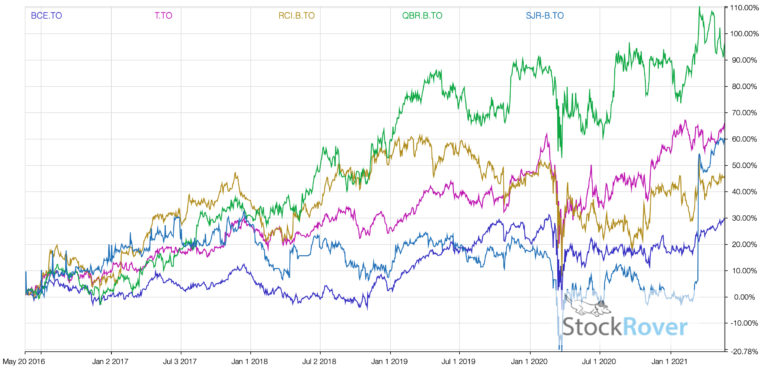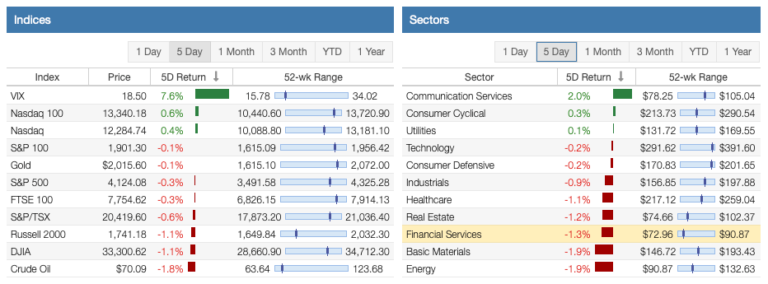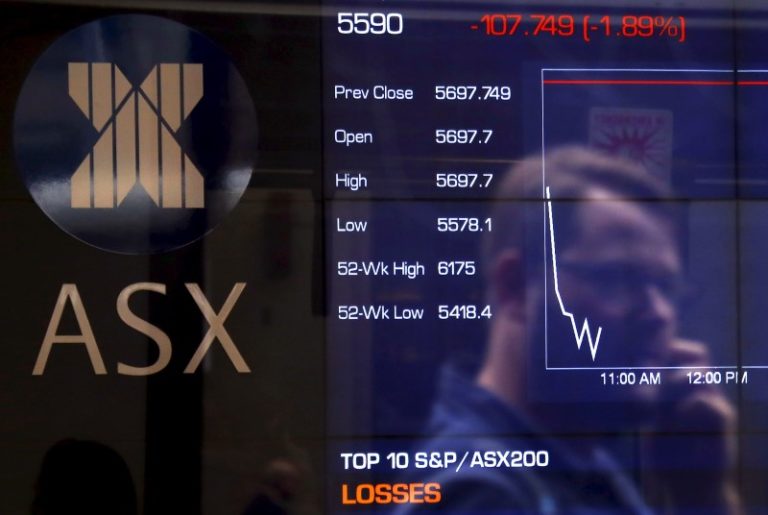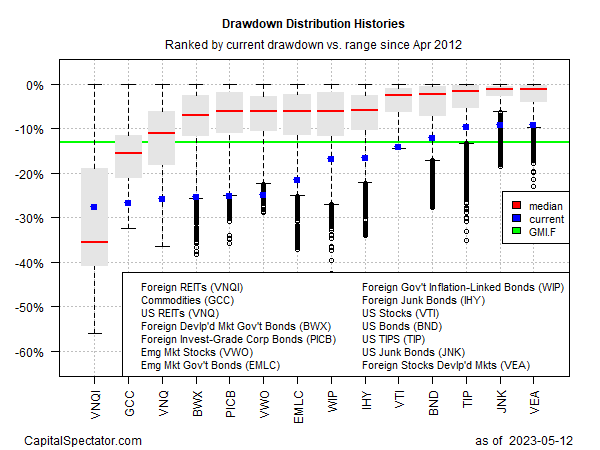
Is Verizon a Good Dividend Stock
Since my last post, the stock market looked like it will have a correction that will allow us all to buy high-quality stocks at a better price. However, the stock market did a 180-degree turn higher. The S&P 500 had a quick run-up in just three weeks. In three weeks, the S&P 500 ran up 6.4%. For some context, a 6.4% increase is what the S&P 500 does in a typical year. But, thus far, the S&P 500 has been up 25.8% since the start of this year. So, we need to look deep into the back of the store to find high-quality stocks at a discount. In this article, we will discuss such a stock. We will address if Verizon is a good dividend stock?

If you are interested in investing in stocks that pay dividends I recommend signing up for the Sure Dividend Newsletter*. It is a good value and one of the best dividend newsletters available. There is a 7-day free trial and grace period so it is risk free. The service provides top 10 stock picks with discussion of advantages, valuation, and risks. I highly recommend them and use their insights for my own stock research. If you want to educate yourself more about dividend investing, then I suggest taking a course. The Simply Investing Course* is a good value and fairly comprehensive.
Overview of Verizon
Verizon Communications Inc. (VZ) is an American multinational telecommunications conglomerate and a Dow Jones Industrial Average (DJIA) corporate component. Verizon is the result of the acquisition of NYNEX, the merger between Bell Atlantic and Vodaphone, followed by the merger with GTE. Since then, Verizon has acquired MCI Worldcom, Alltel, and smaller wireless companies. Verizon also acquired AOL and parts of Yahoo, which were later sold. In addition, Verizon has been slowly divesting wireline operations. The company is headquartered in Midtown Manhattan, New York City, but is incorporated in Delaware. Verizon’s mobile network is the second-largest wireless carrier in the United States, with 120.9 million subscribers by the end of Q4 2020. As of 2017, it is also the second-largest telecommunications company by revenue after AT&T. Total revenue was $128,292 million in 2020 and $134,238 million in the LTM.
Verizon stock has lagged the overall market as it is down (-11%) this year. This fact is why we will be discussing Verizon as a good dividend stock for those investors looking for income now.
Verizon Dividend History, Growth, and Yield
We will now look at Verizon’s dividend history, growth, and yield. We will then determine if it’s a good buy at the current price.
Verizon has been growing its dividend for 17 consecutive years, making Verizon a Dividend Challenger. Verizon is a blue-chip stock and has reliably paid its dividend. Verizon has had an average dividend growth rate of 2.60% CAGR in the last ten years, which is slightly higher than the inflation rate. Over the past five years, Verizon’s dividend growth rate has been 2.22% CAGR, as seen in the chart from Portfolio Insight*. This rate is more in line with the overall historical inflation rate. The main appeal of owning this stock is the high dividend yield.

So, the dividend growth rate has slowed down compared to its last 10-year average. This fact is concerning as a dividend growth investor. We would like to see companies grow their dividends faster than inflation and keep up with that higher dividend growth history as dividend growth investors. The slower 5-year dividend growth shows me that earnings and overall Company growth are also slowing. However, as long as the dividend increase at the rate of inflations or higher, I am a happy dividend investor.
Also, this is a critical point about the company’s dividend that I think is very significant. Verizon continued to pay its dividend during the most challenging period in the last 100 years. Most businesses and industrials were cutting or suspending their dividends payments the previous year during the COVID-19 pandemic; Verizon continued to pay its dividend. The company increased its dividend by 2% in September of last year and 2% in September of this year. The dividend was increased this year was from $0.6275 to $0.64 per share. That tells me everything I need to know about the dividend policy and dividend safety focus, but I do not like the slower growth compared to its five-year average.
The company has an excellent dividend yield of 4.83% as of this writing. This value is a good starting yield for dividend growth investors—especially those investors who are leaving the bond market looking for higher yields. The yield is even higher than the start of 2021, when Verizon was on the Dogs of the Dow 2021 list. Income-driven investors may want a 4.5% yield or higher. So, Verizon does meet that criterion, and it is a good dividend stock for them.
Verizon’s current dividend yield is 39 basis points higher than its own 5-year average dividend yield of 4.44%. I like to look at this metric because it gives me a good idea if a company I am researching is undervalued or overvalued based on the current and 5-year average yield. The reason is that price and dividend yield correlate with one another. If the price goes higher, then the dividend yield goes lower. Vice versa as well.
Is the dividend safe? We should always ask this question if we are looking for an undervalued dividend growth stock to invest in. Sometimes undervalued dividend stocks can present us with a “value trap,” and the stock price can continue to head lower.
Hence, looking at the dividend payout based on earnings and free cash flow (FCF) is essential. Analysts predict that Verizon will earn $5.37 per share for the Fiscal Year (FY) 2021. Analysts are pretty accurate when estimating Verizon’s future earnings. The company is expected to pay out $2.54 per share in dividend for the entire year. Using the dividend payment gives us a payout ratio of 47% based on earnings. Having a 47% dividend coverage with a dividend yield of over 4.0% is very safe.
On a free cash flow (FCF) basis, Verizon has a dividend payout ratio of 43%. This percentage is based on an operating cash flow (OCF) of $41,768 million in 2020 and capital expenditures of $18,192 million. FCF is $23,576 million. The dividend required $10,232 million. Thus, the dividend is well covered by both earnings and free cash flow. Good dividend safety is one reason why Verizon is a good dividend stock.
Capital expenditures have been reasonable for the past few years and are not getting out of control, ranging between $16.6 billion and $18.2 billion over the past 5-years. However, with the rollout of 5G technologies, the trailing twelve months of capital expenditures are likely to grow in the near future. However, dividend safety should not be significantly impacted.
Verizon Revenue and Earnings Growth / Balance Sheet Strength
This section will look at how well Verizon has grown earnings and revenue throughout the years. When evaluating a company, these two metrics are at the top of my list to consider. Without revenue growth, a company can’t have sustainable earnings growth and continue paying a rising dividend.
For the past ten years, Verizon has had revenue increasing at a Compound Annual Growth Rate (CAGR) of 1.6%, which is a meager growth rate considering the size of Verizon. Net income, however, tells a different story. Net income has increased during the past ten years at a pace of 24.9% CAGR. Growing income and flat revenue mean that the management has increased operating and net profit margins and is running a lean and better company than before, as seen in the chart from TIKR.com.

Earnings have seen a much better growth rate when compared to revenue. EPS has grown 9.6% CAGR annually for the past ten years. And over the past five-year, EPS has had a CAGR of 6.0%. So, the company’s earnings growth has slowed down over the past five years. We see now why the dividend growth rate has also slowed down. This fact tells me that the management team is being conservative with the dividend growth policy, which is a good thing, in my opinion.
Last year’s EPS increased from $4.81 per share in 2019 to $5.37 per share for 2020, increasing 11.6%. The growth rate is pretty good considering the tumultuous year the market had last year with the COVID-19 pandemic. In addition, while most companies cut the dividend and/or decreased earnings, Verizon increased its dividend and earnings. Also, analysts expect Verizon to make $5.37 per share for 2021, a 10% increase compared to 2020, which is impressive and driven mainly by the 5G revolution.
Also, the company has a solid balance sheet. Currently, Verizon has an S&P credit rating of BBB+, a Moody’s credit rating of Baa1, and a Fitch credit rating of A-, which are investment-grade ratings. In addition, the company has a long-term debt/cap ratio of 65%, which is high, but reasonable considering that this sector is very capital intensive. And the interest coverage ratio of 8.7X, which is very good. Thus, the company looks to be in an excellent position and will continue to cover the dividends and pay its debt.
One concern is that total debt is rising. This is because telecommunications companies must continuously invest in their network. At the end of Q3, 2021, Verizon had $7,515 million in current long-term debt and $143,056 million in long-term debt. This debt is offset by only $10,153 million in cash, cash equivalents, and short-term securities. As a result, the leverage ratio is about 3X. In general, leverage ratios below 2.5X are better, but Verizon has a high cash flow and can meet its financial obligations.
Verizon’s Valuation
One of the valuation metrics that I like to look for is the dividend yield compared to the past few years’ histories. I also want to look for a lower price-to-earnings ratio (PE) based on the past 5-year or 10-year average. Furthermore, I like to use the Dividend Discount Model (DDM). I use a DDM analysis because a business is ultimately equal to the sum of the future cash flow that that business can provide.
Let’s first look at the PE ratio. Verizon has a PE ratio of 9.9 based on FY 2021 earnings of $5.37 per share. The PE multiple is very low compared to the past 5-year PE average of 12.3. If Verizon were to vert back to a PE of 12.3, we would obtain a price of $66.05 per share.
Now let’s look at the dividend yield. Like I mentioned, the dividend yield currently is 4.83%. Based on Verizon’s own 5-year dividend yield average of 4.44%, there is a potential upside. For example, if Verizon were to return to its dividend yield 5-year average, the price target would be $57.21.
The last item I like to look at to determine a fair price is the DDM analysis. I factored in a 9% discount rate and a long-term dividend growth rate of 3%. I use a 9% discount rate because of the higher current dividend yield. The projected dividend growth rate is a little higher than its 10-year average. This gives us a fair price target of $43.60 per share.
If we average the three fair price targets of $66.05, $57.21, and $43.60, we obtain a reasonable, fair price of $55.62 per share. This gives Verizon a possible upside of 5.0% from the current price of $52.99.
Conclusion on Is Verizon a Good Dividend Stock
Verizon is not a growth stock that will make you rich in a decade if you put all your money into this stock. However, Verizon is a solid, stable stock that will provide you with about 8 – 10% annual return for the foreseeable future. In addition, the company has an excellent dividend yield, and the dividend will likely continue to grow. Hence, Verizon is a good dividend stock for investors looking for a high-yield defensive stock.
Thanks for reading Is Verizon a Good Dividend Stock!
If you are interested in reading about another dividend growth stock please read Walgreens Boots Alliance (WBA) – An Undervalued Dividend Aristocrat.
Author Bio: My name is Felix, and I am a Dividend Growth Investor who has been investing in dividend growth stocks for the past seven years. I also run a YouTube channel called FiscalVoyage. I have written for SeekingAlpha.com as well as SureDividend.com. I focus on undervalued dividend growth stocks that have the potential for capital return and dividend income. Make sure to follow me on my YouTube Channel. See you there.
Disclosure: Felix is long WBA
Here are my recommendations:
If you are unsure on how to invest in dividend stocks or are just getting started with dividend investing. Take a look at my Review of the Simply Investing Report. I also provide a Review of the Simply Investing Course. Note that I am an affiliate of Simply Investing.
If you are interested in an excellent resource for DIY dividend growth investors. I suggest reading my Review of The Sure Dividend Newsletter. Note that I am an affiliate of Sure Dividend.
If you want a leading investment research and portfolio management platform with all the fundamental metrics, screens, and analysis tools that you need. Read my Review of Stock Rover. Note that I am an affiliate of Stock Rover.
If you would like notifications as to when my new articles are published, please sign up for my free weekly e-mail. You will receive a free spreadsheet of the Dividend Kings! You will also join thousands of other readers each month!
*This post contains affiliate links meaning that I earn a commission for any purchases that you make at the Affiliates website through these links. This will not incur additional costs for you. Please read my disclosure for more information.
Published at Tue, 02 Nov 2021 04:00:00 -0700




